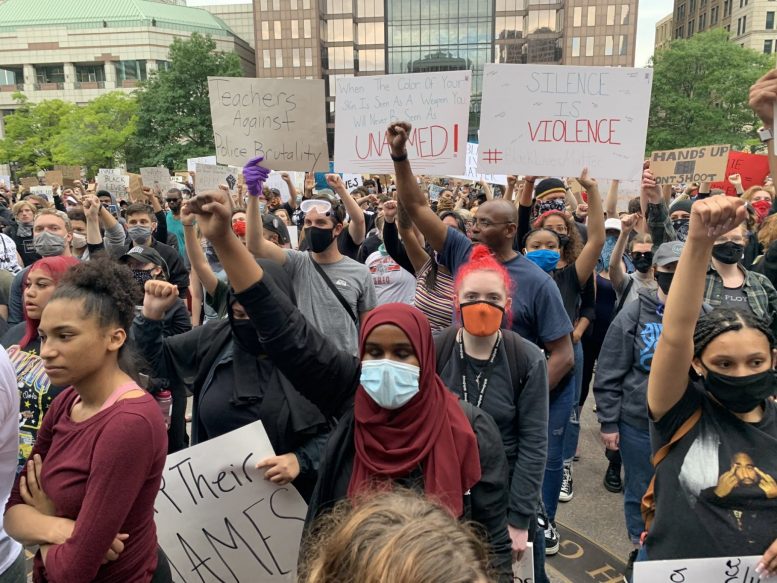Police already have been overly aggressive in this year’s civil rights protests, some protesters say. If Ohio adopts enhanced penalties related to protests, that will only aggravate the problem, they say.
Worse, according to the activists, the bill’s provision allowing deadly force by people who feel threatened during “riots” will only encourage people to go to protests seeking violence.
In contrast, the bill’s sponsors last week didn’t acknowledge that police had engaged in misconduct in Ohio or elsewhere during last summer’s wave of civil rights protests — which were themselves touched off by police misconduct when a Minneapolis police officer knelt on an unarmed Black man’s neck for more than eight minutes, killing him.
The legislation, House Bill 784, was introduced by two lawmakers from Southwest Ohio on Thursday.
In addition to allowing people to use deadly force in what is loosely defined as a “riot,” the bill also would make felonies of what currently are riot-related misdemeanors.
Also, it would allow law-enforcement officers claiming harm in demonstrations to sue any organization supporting the demonstration for treble damages. Taken together, HB 784’s provisions are meant to intimidate protesters from turning out in the first place, said one activist.
“It’s terrifying,” Samantha Grimsley said at rally outside the Statehouse last week against HB 784. “It’s meant to keep people from wanting to come out.”
That’s not how its sponsors see it.
“Our legislation is straightforward. It embraces the right of all Americans to step forward and peaceably assemble and make their voices heard,” one of them, Rep. Cindy Abrams, R-Harrison, told the House Criminal Justice Committee. “But it also says that when you break the law, there will be consequences. Freedom and speech and freedom of assembly are important cornerstones of our democracy. Whether I agree or disagree with what someone has to say, I will defend their right to say it.”
The bill is divorced from the reality of what police did last summer during protests of the Georgy Floyd killing, activists say.
On May 29, the day Floyd was killed, Columbus police moved in, using pepper spray to disburse a crowd, part of which was throwing water bottles into the police line. In the aftermath, some smashed downtown windows — including at the Ohio Statehouse.
Whether the protests themselves or the aggressive response by police are most culpable for the damage is hotly debated. But in the ensuing weeks, police were repeatedly criticized for aggressive tactics.
For example, police on May 30 pepper-sprayed a crowd that included U.S. Rep. Joyce Beatty, Columbus City Council President Shannon Hardin and Franklin County Commissioner Kevin Boyce — all Black. Beatty said that one protester had a foot in the street as police were trying to keep the crowd on the sidewalk.
Grimsley said the summer saw many, many instances of overly aggressive policing in Columbus.
“George Floyd brought me out, but the police kept me out,” she said.
Across the country, police excesses during the protests seemed rampant. The news organization ProPublica in July reviewed 400 videos posted on social media and found “troubling conduct” in almost half of them, including improper use of pepper spray and punching and kicking protesters.
Police also went after journalists in the protests, with the U.S. Press Freedom Tracker reporting more than 328 “press freedom violations” between May 26 and June 6, Forbes reported. In Columbus, reporters — including student journalists — also reported being attacked by police during the protests.
But on Thursday, HB 784 cosponsor Sara Carruthers, R-Hamilton, didn’t acknowledge police misconduct. She said that police only use mace or pepper spray after multiple warnings. As for the pepper-spraying of Beatty and the other elected officials, she said, “I don’t know those people, so I don’t know. But I do know for a fact that (police) tell you at least three or four times ‘Please step back,’ and they do it in a very polite fashion.”
The bill’s sponsors appeared struggle to explain its provision to allow deadly force by people who feel threatened in protests.
Abrams described a situation in which a motorist might find himself or herself engulfed by demonstrators and in fear of being attacked as a situation where deadly force would be justified. Indeed, in early July a disabled Columbus man inadvertently drove amid a demonstration at Broad and High streets, where angry protesters did more than $8,000 worth of damage to his car before other protesters pulled him to safety.
But Aileen Day, who helped organize last week’s demonstration against HB 784, said its deadly force provision has other implications. She said that during last summer’s demonstrations, some people — including white supremacists — went to protests looking for violence. She said she’s terrified that the bill’s sanction of deadly force would only embolden them to start trouble and then kill.
Amid violent protests in Kenosha, Wisc., in August, police praised armed civilians for turning out to protect businesses. Then one of them, 17-year-old Kyle Rittenhouse, used his AR-15 to kill two men and wound another. His supporters say he acted in self defense, but Rittenhouse is now faces homicide and other charges.
On Thursday, Ohio Rep. Jeffrey Crossman, D-Parma, wanted to know if HB 784 might incentivize armed people to go to protests looking for violence. Carruthers said, “If it was pre-planned, they will be dealt with.”
“Are they going to be charged with a homicide, or are they going to be excused under this bill?” Crossman asked.
Abrams didn’t seem to know the answer.
“I’m not a prosecutor and I am certainly not a judge and I’m certainly not a homicide detective, so that would be up to them to decide who they’re going to charge,” she said.
***
Also from Ohio Capital Journal:
Washington at a standstill, as states face the loss of federal help amid ‘the worst part of the crisis’
WASHINGTON — The number of coronavirus infections across the country is swelling at a perilous time for state governments, just weeks before federal support rushed through Congress in the pandemic’s early stages is set to end.
The expiring provisions from the $2 trillion CARES Act and subsequent executive orders will mean reductions in unemployment benefits for those struggling to find work, the loss of eviction protections, and a restart to monthly student loan bills that had been suspended.
Those changes heading into the darkest months of winter will not only hit hard at vulnerable Americans. They’ll increase the fiscal strain on state governments, which are facing a deadline to spend any remaining federal dollars received for pandemic-related costs — or send that money back to Washington. And the critical moment is coming at a time when a new president has been elected, the current president is refusing to concede and Congress is unable to muster the consensus to take action.
“It really is becoming a problem, in that I think the people in the White House are focused on fighting elections and the people in the Biden administration don’t have any information and haven’t taken over, and there’s a little bit of a vacuum right now,” Maryland Gov. Larry Hogan, a Republican, said during a recent news conference. READ MORE
Doctors: Telehealth medicine becoming the norm, needs to be law
The dramatic increase in the demand and use of telemedicine will continue through the pandemic, but should also be maintained as an option afterward, according to medical professionals.
Physicians and medical groups support an Ohio bill which would expand regulation of telemedicine and even the prices health benefit plans charge for telehealth visits and in-person appointments.
Dr. Arick Forest, President of The Ohio State University Physicians, Inc., and Vice Dean for Clinical Affairs at the Ohio State University Wexner Medical Center, said the progress made in utilizing telehealth would be lost if the regulations put in place in response to the COVID-19 pandemic were allowed to expire, and will force the health care system to play catch-up later.
“The pandemic probably pushed us forward four or five years in implementing telehealth as a way to provide care to the population in the state of Ohio,” Forest said at a recent hearing for the bill at the Ohio Senate Insurance and Financial Institutions Committee. READ MORE
Ohio lawmaker plans bill to rescind health order on business mask enforcement
A Republican state senator says Ohio should strike down a recent order from the state health department requiring businesses to take a heavier hand in enforcing mask mandates for customers.
Sen. Dave Burke, R-Marysville, told the Ohio Capital Journal a bill will soon be introduced to achieve just that, the latest in a string of proposed laws targeting the health department’s authority in responding to the ongoing pandemic.
The state mask mandate itself is not under threat, Burke said. But the legislator takes issue with a recent health order first outlined by Gov. Mike DeWine in an evening televised address on Nov. 11. READ MORE





